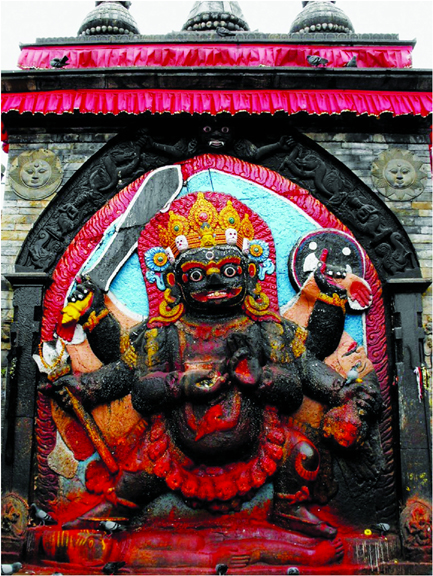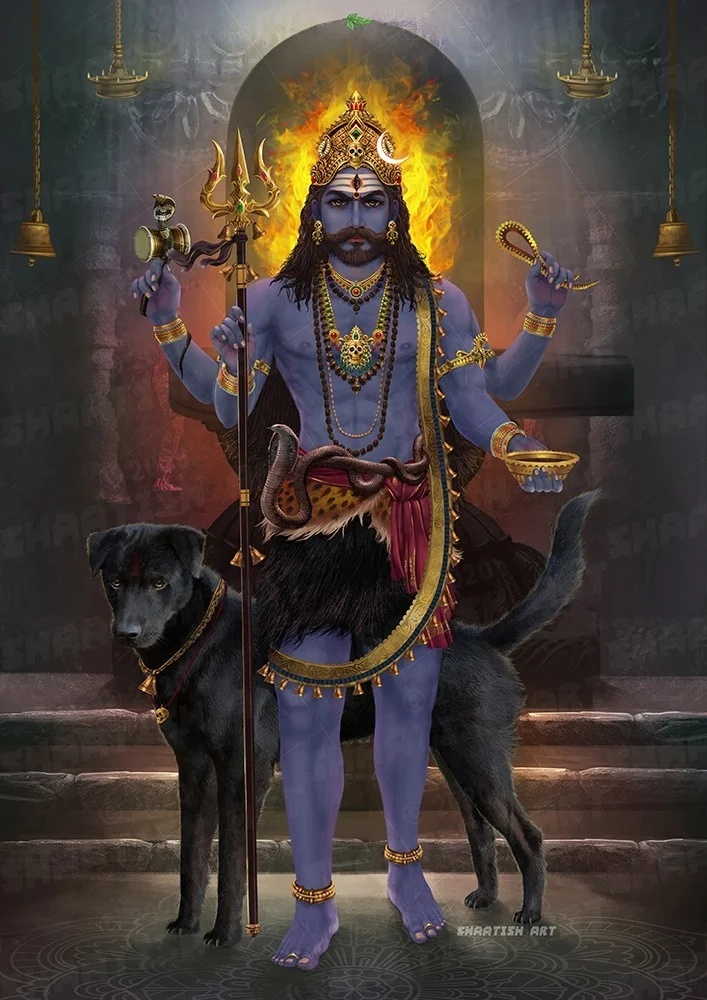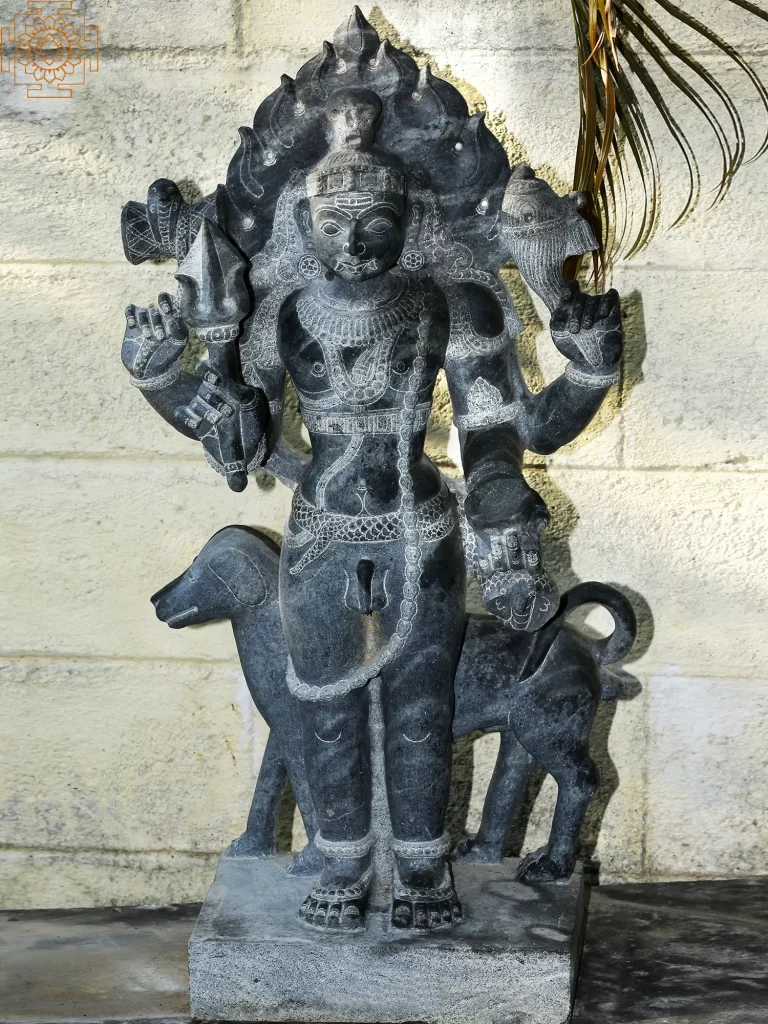Introduction: Mysteries of Kaal Bhairav – The Fierce Guardian Deity
Welcome, dear readers, to a captivating journey into the mystical realm of Hindu mythology! Today, we delve into the enigmatic world of Kaal Bhairav, an awe-inspiring deity who holds a significant place in ancient legends. Join us as we unravel the mysteries surrounding this mighty guardian and explore the tales that have fascinated generations.
Table of Contents
The Origins of Kaal Bhairav

In Hindu mythology, Kaal Bhairav is believed to be an incarnation of Lord Shiva, the supreme god. He manifests as a fierce form with a fearsome appearance, adorned with serpents and often depicted holding a trident or a sword. “Kaal” represents time, while “Bhairav” signifies the untamed and formidable aspect of the divine.
The Guardian of Time and Space
Kaal Bhairav assumes the critical role of safeguarding the delicate balance of time and space. Just as a clock governs the passage of time, Kaal Bhairav ensures that the universe operates harmoniously. He oversees the rise and setting of the sun, the changing of seasons, and the celestial cycles, ensuring everything unfolds according to the grand design.
Devotion and Rituals
Devotees flock to temples dedicated to Kaal Bhairav, offering prayers and seeking his divine protection. Flowers, incense, and sweets are offered as symbols of reverence and devotion. People believe that by expressing their faith and respect, they can receive blessings, ward off evil, and find guidance in their lives.
The Lessons of Kaal Bhairav
Kaal Bhairav’s tales teach us valuable lessons that resonate beyond the boundaries of mythology. His fierce appearance reminds us that strength and power should be used wisely and compassionately. His commitment to justice teaches us the importance of upholding fairness and standing up against injustice.
Courage and Facing Challenges
Kaal Bhairav embodies courage and fearlessness. His stories inspire us to confront our fears and overcome challenges. We learn that with determination and belief in our abilities, we can triumph over any adversity that comes our way.
Balancing Time and Responsibilities
Through Kaal Bhairav’s role as the guardian of time, we understand the significance of managing our time effectively. Just as Kaal Bhairav ensures the cosmic order, we can learn to prioritize our tasks, fulfill our responsibilities, and value the precious moments we have.
Reflecting on Kaal Bhairav’s Teachings
Let us contemplate the teachings of Kaal Bhairav and apply them in our daily lives. We can cultivate strength, kindness, and fairness, and make a positive impact on the world around us. When faced with difficult decisions, we can seek solace in the divine wisdom of Kaal Bhairav and trust in the guidance that comes our way.
FAQS On Kaal Bhairav
Is Kaal Bhairav Good or Bad?

The characterization of Kaal Bhairav as good or bad is subjective and depends on individual perspectives. In Hindu mythology, Kaal Bhairav is often depicted as a fierce and powerful deity with a significant role in maintaining order. While his appearance may seem intimidating, his actions are driven by a sense of justice and balance.
He punishes wrongdoers and protects the innocent. However, it is important to remember that Hindu mythology encompasses a complex understanding of divinity, where deities embody multiple aspects and can’t be confined to simple labels of good or bad. The significance of Kaal Bhairav lies in his role as a guardian, representing the dynamic and multifaceted nature of the divine.
Why Did Shiva Create Kaal Bhairav?

According to Hindu mythology, the creation of Kaal Bhairav by Lord Shiva serves a specific purpose. It is said that during a fierce battle, Lord Shiva became enraged and manifested his intense anger as a separate form known as Kaal Bhairav. Lord Shiva created Kaal Bhairav to unleash and contain his destructive energy, ensuring that it was channeled in a controlled manner.
Kaal Bhairav’s formidable presence and power help maintain balance in the universe and act as a protector against evil forces. The creation of Kaal Bhairav by Lord Shiva signifies the recognition and management of intense emotions and the need for a designated entity to embody and control such primal forces.
Why Is Kaal Bhairav Puja Done?
Kaal Bhairav Puja, or the worship of Kaal Bhairav, holds significant importance in Hindu traditions. The puja is performed to seek the blessings and protection of Kaal Bhairav, who is considered the guardian and keeper of time and space.
Devotees believe that by conducting the puja, they can appease Kaal Bhairav and receive his divine grace and guidance. The puja is often performed to overcome obstacles, to seek solutions to problems, and to attain spiritual growth and inner strength.
It is believed that by honoring Kaal Bhairav through this sacred ritual, individuals can gain protection from negative energies, receive clarity of mind, and experience a sense of balance and harmony in their lives. The Kaal Bhairav Puja is a way for devotees to express their devotion, gratitude, and reverence towards this powerful deity.
Is Bhairav Son of Shiva?
Yes, Bhairav is considered to be an aspect or manifestation of Lord Shiva in Hindu mythology. Bhairav is often regarded as the fierce form of Shiva and is associated with tremendous power and intensity. In some traditions, Bhairav is considered to be a son or an emanation of Shiva.
However, it is important to note that Hindu mythology is rich with diverse interpretations, and different sects and regions may have varying beliefs and legends surrounding Bhairav’s origin. Nevertheless, the association between Bhairav and Shiva is deeply ingrained in Hindu mythology, depicting the dynamic and multifaceted nature of the divine.
What Are The 8 Names of Kaal Bhairav?
Kaal Bhairav is revered by various names, each representing a different aspect or characteristic of his divine persona. The eight names associated with Kaal Bhairav are:
- Asitanga Bhairava: This name signifies Kaal Bhairav’s dark or black complexion and his fierce appearance.
- Ruru Bhairava: Ruru refers to his association with the Ruru animal, a type of dog. It represents his protective and vigilant nature.
- Chanda Bhairava: Chanda represents his intense and fierce form, symbolizing his power and ferocity.
- Krodha Bhairava: Krodha represents anger, and this name signifies Kaal Bhairav’s role as the embodiment of Lord Shiva’s wrathful energy.
- Unmatta Bhairava: Unmatta means “mad” or “intoxicated.” This name highlights his ecstatic and transcendental state, representing his liberated consciousness.
- Kapala Bhairava: Kapala signifies a skull, and this name represents Kaal Bhairav’s association with the skull as a symbol of transformation and transcendence.
- Bhishana Bhairava: Bhishana means “terrifying” or “frightful.” This name reflects his awe-inspiring and fearsome appearance.
- Samhara Bhairava: Samhara denotes destruction. This name signifies Kaal Bhairav’s role in removing obstacles and destroying negative forces to create space for renewal and growth.
Is Mahakal and Kalbhairav Same?
In Hindu mythology, Mahakal and Kalbhairav are related but distinct deities. Mahakal, also known as Mahakaleshwar, is a name commonly associated with Lord Shiva. It represents his aspect as the Supreme Lord of Time and the eternal destroyer of the universe. Mahakal signifies the ultimate reality and cosmic power of Shiva.
On the other hand, Kalbhairav is a specific manifestation of Lord Shiva, often depicted as a fierce and powerful deity. Kalbhairav is associated with the protection of time and space, ensuring order and justice in the universe. While both Mahakal and Kalbhairav share connections to Lord Shiva, they represent different aspects of his divine nature.
Mahakal emphasizes Shiva’s overarching presence and authority over time and existence, while Kalbhairav emphasizes his fierce and protective qualities as a guardian deity. Thus, while they are related, Mahakal and Kalbhairav can be seen as distinct expressions of Shiva’s multifaceted nature within Hindu mythology.
Who Can Worship Kaal Bhairav?
Kaal Bhairav, a revered deity in Hindu mythology, welcomes the devotion of all individuals who seek his blessings and guidance. The worship of Kaal Bhairav is not restricted by age, gender, or social status; it is open to everyone. Whether young or old, male or female, anyone can approach Kaal Bhairav with sincerity and reverence.
His divine presence is accessible to all who seek spiritual growth, protection, and inner strength. People from diverse backgrounds and beliefs can perform rituals, visit Kaal Bhairav temples, and offer prayers to connect with his powerful energy.
The worship of Kaal Bhairav provides solace, guidance, and a sense of divine support to those who embark on their spiritual journey, making him an inclusive and accessible deity for all who seek his blessings.
Why Is Alcohol Offered to Kaal Bhairav?
In certain regions and traditions, it is believed that offering alcohol to Kaal Bhairav during worship is a way to appease and honor him. This practice stems from the understanding that Kaal Bhairav represents the transformative and intense aspects of existence.
Alcohol, when offered with devotion and in moderation, is seen as a symbolic offering that represents the release of inhibitions, transcending mundane limitations, and embracing the ecstatic and liberated state of consciousness.
It is important to note that this practice may not be prevalent in all regions or for all devotees, and individual beliefs and customs may vary. Ultimately, the offering of alcohol to Kaal Bhairav is a reflection of the diversity and intricate tapestry of customs within Hindu mythology and should be understood within the cultural context where it is practiced.
What If I See Lord Kaal Bhairav in Dream?
If you see Lord Kaal Bhairav in a dream, it can be considered a significant and auspicious experience. Dreams have long been regarded as a means of divine communication and guidance in many cultures. Seeing Lord Kaal Bhairav in a dream may signify his divine presence, blessings, or a message meant specifically for you.
It is advisable to reflect upon the dream and try to understand the symbolism and meaning it holds for you personally. It is also believed that such dreams can indicate divine protection, spiritual progress, or the need for self-reflection and transformation.
Embrace the experience with reverence and gratitude, and if you feel inclined, seek guidance from a spiritual advisor or reflect on the dream’s significance within the context of your own spiritual journey.
Which Days to Worship Kaal Bhairav?
The worship of Kaal Bhairav does not have specific days that are exclusively designated for his worship, as devotion to him can be practiced on any day. However, there are certain days that hold special significance and are considered auspicious for Kaal Bhairav worship.
These include Tuesdays, which are associated with Lord Bhairav, as well as Saturdays, which are dedicated to Lord Shiva. Additionally, the festival of Kalashtami, which falls on the eighth day of the lunar fortnight, is considered highly auspicious for Kaal Bhairav worship.
Devotees often observe fasts, perform special rituals, and offer prayers on these days to seek the blessings and protection of Kaal Bhairav. Nevertheless, it is important to remember that devotion to Kaal Bhairav can be practiced on any day with sincerity, reverence, and a genuine desire to connect with his divine energy.
Can We Keep Kaal Bhairav Idol in Home?
Yes, it is possible to keep a Kaal Bhairav idol in your home for worship. Many devotees choose to have idols or images of Kaal Bhairav in their households as a means of expressing their devotion and seeking his blessings.
Before keeping the idol, it is advisable to perform a consecration ceremony or seek guidance from a priest to ensure proper rituals are followed. It is important to maintain the sanctity of the idol by offering regular prayers, performing rituals, and keeping the space clean and dedicated for worship.
The presence of a Kaal Bhairav idol in the home can serve as a source of inspiration, protection, and a focal point for spiritual practice. However, it is essential to approach the worship with sincerity, reverence, and a genuine understanding of the deity’s significance in Hindu mythology.
Conclusion
As we conclude our expedition into the realm of Kaal Bhairav, we emerge with a deeper understanding of this fierce and revered guardian deity. His embodiment of time, his commitment to justice, and his powerful presence leave an indelible mark on our hearts and minds. Let us cherish the lessons we have learned from Kaal Bhairav and continue our exploration of the rich tapestry of mythology, where countless enchanting tales await us.
Reference
- Gopal, Madan (1990). Gautam, K.S. (ed.). India through the ages. Publication Division, Ministry of Information and Broadcasting, Government of India. p. 76.
- ^ “Bhairava: The Wrathful”. Archived from the original on 13 February 2015. Retrieved 13 May 2015.
- ^ Jump up to:a b Singh, J. (2002). Vijnanabhairava, Or Divine Consciousness: A Treasury of 112 Types of Yoga. Tantra Series. Motilal Banarsidass. p. 1. ISBN 978-81-208-0820-1.
- ^ Jump up to:a b Wallis, Christopher D. (15 August 2013). Tantra Illuminated: The Philosophy, History, and Practice of a Timeless Tradition. Mattamayura Press. ISBN 978-0-9897613-6-9.
- ^ Sehgal, Sunil (1999). Encyclopaedia of Hinduism: C-G, Volume 2. Sarup & Sons. pp. 491–492. ISBN 9788176250641.
